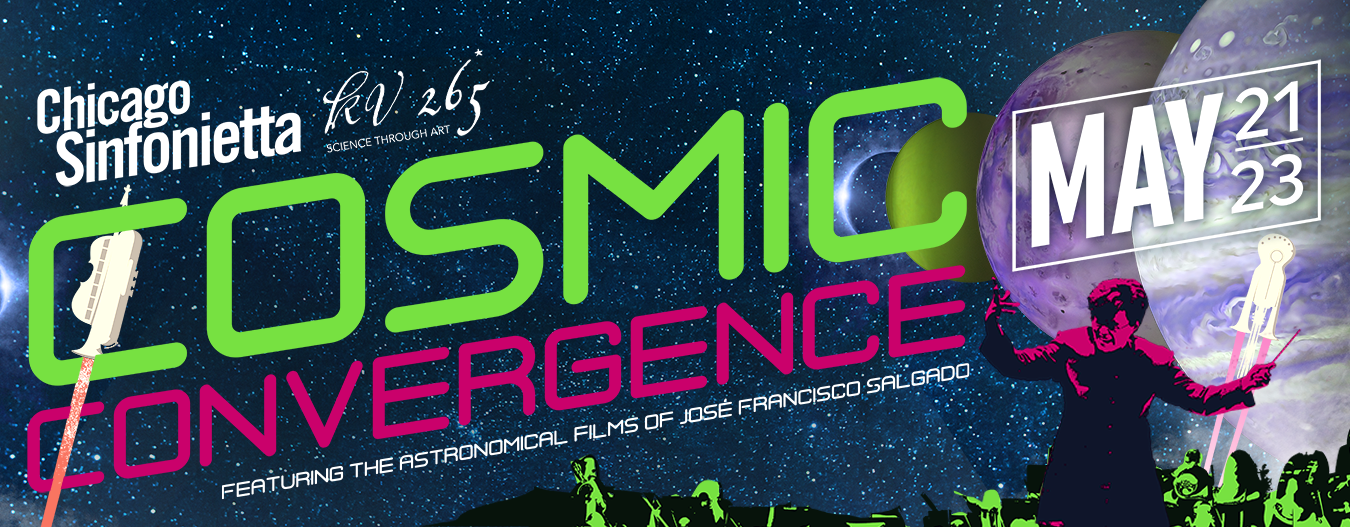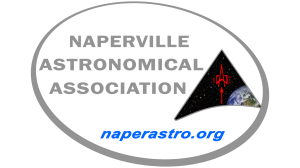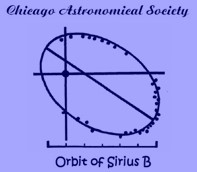- Home
- Concerts & Events
- Plan Your Experience
- About
- Initiatives & Community
- Get Involved
- Support
Digital Guide to Cosmic Convergence
Exactly ten years ago in the spring of 2006, Chicago Sinfonietta worked with a young astronomer and visual artist at the Adler Planetarium to create a film that would accompany a performance of Holst’s The Planets. Since then, José Francisco Salgado would go on to found a non-profit dedicated to using film and music to spur interest in science, collaborating with musicians, composers and orchestras around the world. We welcome back Dr. Salgado for this ‘greatest hits’ retrospective of his work plus the Chicago premiere of his latest collaboration, Borealis. We’ll also, as we have all season, pay tribute to Sinfonietta founder Maestro Paul Freeman with the premiere of a brand new work inspired by and in honor of him.
THE
ARTISTS
Mei-Ann Chen, Music Director and conductor
 Mei-Ann Chen is in her fifth season as Chicago Sinfonietta Music Director. In her tenure with the organization, she has brought the orchestra to new artistic heights, developing an aggressively adventurous approach to repertoire and collaboration while firmly anchoring her ambitious plans in the Sinfonietta’s quarter-century plus heritage of diversity, inclusion and service to the community. In the process, she has earned two awards from the League of American Orchestra: The Helen M. Thompson Award, given to a music director every two years to recognize their impact and potential for a significant national career, and one for the orchestra, a First Place Award for Adventurous Programming. Just last year, she was named one of thirty Professionals of the Year by Musical America.
Mei-Ann Chen is in her fifth season as Chicago Sinfonietta Music Director. In her tenure with the organization, she has brought the orchestra to new artistic heights, developing an aggressively adventurous approach to repertoire and collaboration while firmly anchoring her ambitious plans in the Sinfonietta’s quarter-century plus heritage of diversity, inclusion and service to the community. In the process, she has earned two awards from the League of American Orchestra: The Helen M. Thompson Award, given to a music director every two years to recognize their impact and potential for a significant national career, and one for the orchestra, a First Place Award for Adventurous Programming. Just last year, she was named one of thirty Professionals of the Year by Musical America.
As the Chicago Tribune’s John von Rhien has remarked, “Mei-Ann Chen… was born to lead this group. She plays and speaks from the heart, the body and the head, and the audience and players have embraced her.” There’s also this from the Chicagoist blog: “We love Chicago Sinfonietta’s approach to classical music: it really opens it up to a new audience and makes it approachable and interesting.”
Born in Taiwan, Ms. Chen has lived in the United States since 1989. She holds a Doctor of Musical Arts degree in conducting from the University of Michigan, where she was a student of Kenneth Kiesler. Prior to that, she was the first student in New England Conservatory’s history to receive master’s degrees, simultaneously, in both violin and conducting. She is also the Music Director of the Memphis Symphony Orchestra and is in high demand around the globe as a guest conductor.
Mei-Ann Chen's complete biography can be found here.The video is a whirlwind tour of Mei-Ann Chen’s tenure with the orchestra.
José Francisco Salgado, astronomer and visual artist
José Francisco Salgado is an Emmy-nominated astronomer, experimental photographer, visual artist, and public speaker who creates multimedia works that communicates science in engaging ways. As the Executive Director and co-founder of KV 265, a non-profit science and arts education organization, Dr. Salgado collaborates with orchestras, composers, and musicians to present films that provoke curiosity and a sense of wonder about the Earth and the Universe.
Salgado was born in San Juan, Puerto Rico and was first drawn to science as a third grader by a lavishly illustrated book on the space program and the first manned mission to the moon. Fascinated, he began to devour everything he could find on the subject of space. He went on to earn a PhD in Astronomy from the University of Michigan before joining the outreach department of the Adler Planetarium in Chicago. Along the way he developed a strong interest in photography and music, skills that he brought to his work at Adler. Chicago Sinfonietta’s Paul Freeman found him there to begin planning their first collaboration, a film set to Gustav Holst’s The Planets. An immediate smash, the Sinfonietta and Dr. Salgado returned two years later for an encore performance at Millennium Park before an overflow audience of 12,000 people.
Salgado was interviewed by Arte y Vida Chicago. for his last major collaboration with Chicago Sinfonietta, Moonrise. his website plus that of KV 265 provide tons of information on Salgado and his work. The University of Michigan, Salgado’s alma mater, filmed a presentation of Salgado’s in 2009 in which he describes his inspirations and creative process.
Notes From the Founders:
It is not an overstatement to say that Maestro Freeman, Chicago Sinfonietta, and Holst’s magnum opus, "The Planets," led me to where I stand today as an artist and science communicator. After I had spent a few years combining science with art, Maestro Freeman gave me the opportunity to develop these ideas further into what we now call Science & Symphony films. For someone as passionate about music, photography, and science as myself it is hard to beat the power of an orchestra in a concert hall as the forum to reach new audiences. I thank Maestro Freeman for his invitation to work with him and for his warmth when he handed me his own recording of "The Planets." Ten years and 123 concerts later, the KV 265 team and I continue to spread the same multidisciplinary message that was spawned out of those two concerts in 2006. As prolific writer and biochemsit Isaac Asimov said: "There is an art to science, and a science in art; the two are not enemies, but different aspects of the whole.” I am glad Maestro Freeman agreed.
José Francisco Salgado, PhD
Executive Director and Co-Founder, KV 265
Maestro Freeman was always known for giving diverse artists a chance, and ten years ago, he took a chance when he approached a young astronomer to create a new film set to Gustav Holst’s beautiful work, The Planets. Dr. Jose Francisco Salgado, who had never worked with an orchestra, let alone created a major arts project, nevertheless jumped at the chance. Freeman was to discover that Salgado was, not only a scientist, but also an incredible visual artist who possessed an uncanny sense of the music. The Planets, was an incredible success and provided a stunning experience for the audience including the 12,000 people who saw it performed again at Millennium Park.
This final tribute year performance marks the anniversary of a 10 year collaboration with Salgado and Chicago Sinfonietta that led, in 2010, to the formation of KV 265, a Chicago-based non-profit organization whose mission is the communication of science through the arts. Just as Freeman broke down the walls of concert halls, KV 265 is breaking down the silos between arts and science. The Science & Symphony films have now been presented in more than 117 concerts for 265,000 people in Chicago and around the world.
We thank you Maestro Freeman and Chicago Sinfonietta for your incredible vision when you gave another diverse artist a chance and helped to break down yet another set of barriers.
Anne Barlow, KV 265 Co-Founder
Reach for the Sky!
Pre-concert and during intermission audience members will be invited to touch, hear, and observe the universe up close and personal with diverse astronomers from across the city including the Naperville Astronomical Association during the Wentz Concert Hall performance and the Kavli Institute for Cosmological Physics, the Cernan Earth and Space Center, and the Chicago Astronomical Society during the Symphony Center performance.
THE
COMPOSERS
- Roberto Sierra
- Michael Abels
- Piotr Ilyich Tchaikovsky
- Gustav Holst
- John Estacio
- Hector Berlioz
- Modest Mussorgsky (arr. Ravel)
Júbilo
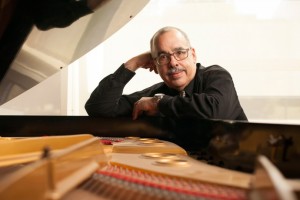 The music of Puerto Rican composer Roberto Sierra is familiar to Chicago’s summer classical music patrons, especially those of the Grant Park Music Festival. Perhaps that is because one thinks of sunshine and warmth when Puerto Rico comes to mind, and indeed, the Caribbean spirit and rhythm that informs much of his music is a perfect match for summer skies. Júbilo was his first major orchestral composition to be performed in the United States, after premiering a year earlier in San Juan by the Puerto Rico Symphony Orchestra.
The music of Puerto Rican composer Roberto Sierra is familiar to Chicago’s summer classical music patrons, especially those of the Grant Park Music Festival. Perhaps that is because one thinks of sunshine and warmth when Puerto Rico comes to mind, and indeed, the Caribbean spirit and rhythm that informs much of his music is a perfect match for summer skies. Júbilo was his first major orchestral composition to be performed in the United States, after premiering a year earlier in San Juan by the Puerto Rico Symphony Orchestra.
Sierra, who studied composition in Europe, maintains the spirit and folklore of his native Puerto Rico in his music. Júbilo means “Joy” in English, and the brief work serves as a lively overture of sorts to start the concert. Sierra has said "I love painting. If I were not a composer, I would be a painter. For example, I love Bosch and Turner, as well as Kandinsky. Anything with great color and fantastic imagery will call my attention." So, before we get to the stunning imagery of Salgado’s films, Sierra’s work will allow us to conjure pictures in our own imaginations, preparing us for the cosmic journey to come.
Roberto Sierra's website has biographical information, music samples and more. The video is a complete performance of his Sinfonía No. 4.
Global Warming, Victory Road (World Premiere)
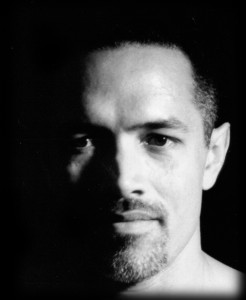 The American composer Michael Abels and Chicago Sinfonietta have a long and fruitful history together. Global Warming, arguably his best known work, was recorded by Paul Freeman and the Sinfonietta and released on their African Heritage Symphonic Series Vol 3 CD in 2000. It has since gone on to over 100 performances around the world. More recently, Abels’ Delights and Dances appeared on the Sinfonietta CD of the same name led by Mei-Ann Chen and featuring the Harlem Quartet. For the Sinfonietta, Abels is a living bridge that connects the legacy of Maestro Freeman to the present day.
The American composer Michael Abels and Chicago Sinfonietta have a long and fruitful history together. Global Warming, arguably his best known work, was recorded by Paul Freeman and the Sinfonietta and released on their African Heritage Symphonic Series Vol 3 CD in 2000. It has since gone on to over 100 performances around the world. More recently, Abels’ Delights and Dances appeared on the Sinfonietta CD of the same name led by Mei-Ann Chen and featuring the Harlem Quartet. For the Sinfonietta, Abels is a living bridge that connects the legacy of Maestro Freeman to the present day.
Global Warming is surprisingly not a reference to climate change. Abels wrote it in 1991, and the term “global warming," let alone the concept that humanity’s actions were contributing to a long term threat to the planet’s survival, was not widely known nor accepted as fact. The first globally observed Earth Day in 1990 brought it more attention, but other things were warming up in the world as well, including what seemed to be a thaw in international relations as the Cold War ended and a hope that humanity could unite in a more harmonious fashion. The title Global Warming, then, is a pun, and the work a generally optimistic statement that brings a host of global musical influences into orchestral form.
Victory Road is Michael Abels’ tribute to Paul Freeman and his groundbreaking accomplishments. It starts simply, almost idyllically, with a clarinet solo, signifying the first instrument that young Paul Freeman took up before becoming a conductor, and it ends there too, but in between a journey and a struggle are evoked to sketch the arc of the maestro’s unlikely accomplishments as an African-American in classical music. It is a celebration of his talent, determination, and hard work, but also of his love for the music.
You’ll find a solid biography of Michael Abels at the Subito Music website. Enjoy the Chicago Sinfonietta recording of Delights and Dances at the video.
Capriccio Italien, op.45
 Seeking a respite from a disastrous marriage, Russian composer Piotr Tchaikovsky took a trip to Rome with his brother Modest in 1880. While there, he became enchanted by the Italian folk music that he heard in the streets. Inspired, he set about to writing musical sketches based on what he was hearing. Adding some scholarship to the mix, a fantasia comprised of these tunes began to take shape. Returning to Moscow, he finished the Capriccio Italien, initially called the Italian Fantasia, and it received its premiere in December of the same year.
Seeking a respite from a disastrous marriage, Russian composer Piotr Tchaikovsky took a trip to Rome with his brother Modest in 1880. While there, he became enchanted by the Italian folk music that he heard in the streets. Inspired, he set about to writing musical sketches based on what he was hearing. Adding some scholarship to the mix, a fantasia comprised of these tunes began to take shape. Returning to Moscow, he finished the Capriccio Italien, initially called the Italian Fantasia, and it received its premiere in December of the same year.
Tchaikovsky, of course, is best known for his larger works, including his immortal ballets, virtuosic concertos, operas and the bombastic 1812 Overture. Capriccio Italien is something a bit different, like a chamber work but written for a full orchestra. It is a fairly short work that starts out with a bugle call and ends up a street dance. As such, it has become something of an orchestral showpiece. Not genuinely Italian, but a Russian’s view on a country he clearly thought fondly of.
The Tchaikovsky Research Project collects all sorts of materials, including personal diaries, pertaining to the composer. Listen to Capriccio Italien via the video.
The Planets, (Mvt. 1, Mars; Mvt. 4, Jupiter)
Tasked with providing the visuals to Gustav Holst’s The Planets, José Francisco Salgado combined computer animation, NASA footage and astrological charts to fashion his first film down the science and symphony path ten years ago.
Holst was an English composer, arranger and teacher. His seven movement suite was composed between 1914 and 1916. Yes, each movement is named after a planet, but Holst was evoking the characteristics of their corresponding astrological signs. Thus, the full name of the first movement is Mars, the Bringer of War. It is not literally about the planet closest to the sun, but rather what humanity had read into its presence in the night sky throughout the ages and the mythological connotations that flow from it. Holst, as it turns out, had a keen interest in astrology, and was sometimes even coaxed to cast his friend’s horoscopes.
Jupiter, subtitled the Bringer of Jollity, is as bright and cheerful as its name suggests and will open the portion of the concert devoted to Salgado’s films. The foreboding strains of Mars will close the first half on a spectacular crescendo.
The Gustav Holst website can take you through his biography, work and critical analysis. The video is a brief clip of Salgado’s visualization of both Mars and Jupiter.
Gustav Holst’s The Planets (excerpts) from Jose Francisco Salgado on Vimeo.
Borealis
It is hard to think of an orchestral work more suited to a music minded astronomer/filmmaker than John Estacio’s Borealis. Unlike The Planets, there is nothing metaphorical about Borealis. It is, quite literally, about the mysterious celestial phenomenon known commonly as the Northern Lights, and Estacio was moved to write it after seeing them for the first time after moving to Edmonton, Alberta. In Edmonton, the aurora borealis are so bright they are visible even through the lights of the city.
Canadian composer John Estacio was born in Ontario of Portuguese ancestry. He started out in music as a church organist and trumpet player, but soon turned to composing as his main vocation. Perhaps foreshadowing what would someday happen when José Francisco Salgado discovered Borealis, he composed soundtracks to films he made with his high school buddies.
Borealis had its world premiere in 1997 by the Edmonton Symphony Orchestra. John Estacio has written over 25 other pieces for orchestra, opera, chamber and choral music. His works are performed throughout North America, and the Sinfonietta performance of Borealis is its Chicago premiere. You can find out lots more about Estacio at his website. The video contains a recording of Borealis by the Edmonton Symphony.
Symphonie Fantastique, Op. 14, Mvt. 2: Un Bal
The American conductor and composer Leonard Bernstein described Symphonie Fantastique as the first musical expedition into psychedelia because of its hallucinatory and dream-like nature. Of course, he did say this during the 1960’s, but Hector Berlioz’s own words tend to back that up: “A young musician of a sensitive nature and a feverish imagination poisons himself with opium in a fit of lovesick despair. The narcotic dose, too weak to cause death, plunges him into a heavy sleep accompanied by the strangest visions, during which his feelings, sensations and memories are translated by his sick brain into musical thoughts and images.” Wow. This psychedelic trip seems almost tailor made for the out-of-this-world imagery of José Francisco Salgado.
Symphonie Fantastique is a programmatic work consisting of five movements, each taking the listener through stages of the young musician’s mental journey. Un bal is, of course, a ball, a dance, an elegant affair, and the recurring waltz theme signifies this. As an early movement, just following the opening Rêveries – Passions, Berlioz has yet to take his character to the depths of despair that follow in later movements. He is not lovesick yet, just merely in love.
The Hector Berlioz website is the personal obsession of a pair of British Berlioz aficionados. The video is a nicely annotated rendering of the entire movement.
Pictures at an Exhibition, Mvts. 9 & 10
With Pictures at an Exhibition, Chicago Sinfonietta and Jose Francisco Salgado revisit excerpts from another one of our groundbreaking collaborations. Like Symphonie Fantastique, the programmatic and storytelling nature of Modest Mussorksky’s signature work lends itself well to imagery. The power of the music itself has not gone unnoticed, as evidenced by the progressive rock band Emerson Lake & Palmer, whose album of the same name was a huge seller and a psychedelic touchstone for a generation.
Not unlike Berlioz’s work, Pictures takes the listener on a journey. This time, though, the journey is through a gallery of paintings, and each movement of the work brings those paintings to life. Mussorgsky wrote the work as a memorial to a deceased artist friend after visiting an exhibit of some 400 of his works mounted after his death. It was originally a suite of 10 piano pieces, but sadly, the score remained unpublished and unperformed until 1886, five years after the composer’s own death at the age of 42. While the solo piano version remains infrequently played, Maurice Ravel's 1922 orchestration became the version that went on to worldwide acclaim.
The Sinfonietta will perform the final two movements (The Hut on Fowl's Legs and The Great Gate of Kiev) in this encore of a concert first presented with Salgado’s visuals in 2008. To read more on the story of Mussorgsky and Pictures, check out this feature from Classical Notes. The video is a live performance of The Great Gate of Kiev.
Research and copywriting by Don Macica.
Don is the founder of Home Base Arts Marketing Services and a contributing writer to several online publications including Agúzate and Arte y Vida Chicago. When not traveling, he lives a stone's throw from Lake Michigan in Chicago’s Rogers Park neighborhood. He is the author of Border Radio, a blog about music, migration and cultural exchange.

